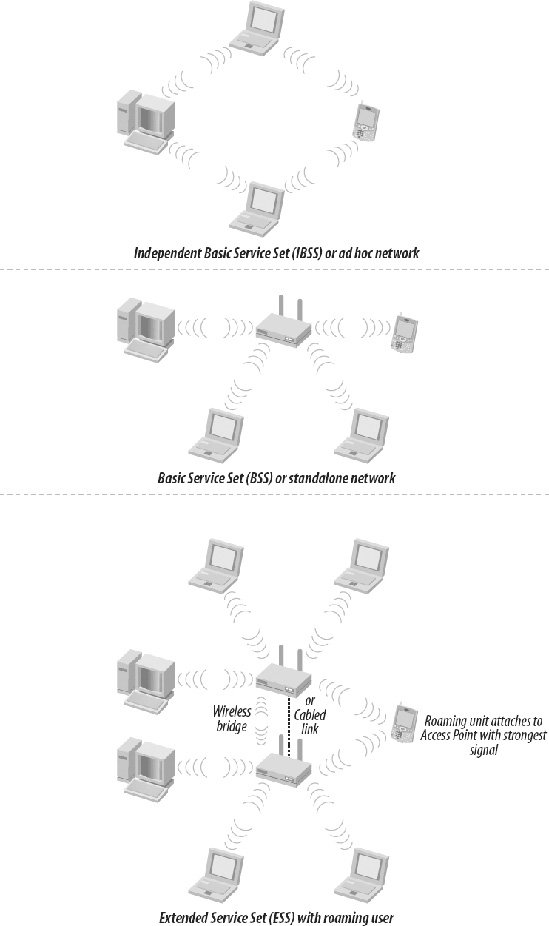Section 10.2. Today s Wireless Infrastructure
10.2. Today's Wireless InfrastructureMany network administrators and most home users have the belief that setting up a wireless network is a self-managing affair. Wireless cards are available for most computers. The thinking in many facilities today seems to be: "Throw in the wireless cards, and you are off." This is called an ad hoc infrastructure. Sure, wireless will work under these conditions but to do so is to invite a security disaster. In this arrangement, units attach freely to each other, and there is no central authority to govern authentication (see Figure 10-1). Figure 10-1. Wireless architectures In contrast, an infrastructure architecture is a wireless network in which all units communicate with one unit that connects to a wired network. Wireless access points (APs) provide an interface between the physical network and the various computers containing wireless cards. This makes sense; after all, most people use wireless not to connect to each other, but to a LAN, or to the Internet. Infrastructure architecture improves security and performance because administrators can monitor central login points to detect illicit access attempts. This architecture also makes network resources available to wireless users in the network, which increases the value of the connection. Each network attachment point and the area it serves is called a basic service set (BSS). If it exists alone on a network, it is called an independent service set (ISS). Two or more basic service sets can exist on the same wired network. Traffic hands off between them depending on which has the stronger signal; this process is called roaming. It is possible to take advantage of wireless to overcome an impassible barrier between two network segments. Used in this way, wireless equipment forms a network bridge. Most access points will function as bridges; however, if the interconnection is between two buildings, there may be an advantage to using specialized hardware that is optimized to withstand exposure to the elements. Home users too have pined for the advantages of a wireless world. Even something as simple as working one's laptop while watching a TV show used to require stringing a long network cable across the floor. This was a trip hazard at the least, and such a cable was often a luxury in its own right. Well-wired houses can be a rarity. The time and tools required to route wires through walls made it a daunting task. A wireless access point connected to a cable or DSL modem makes wireless highly desirable for home use. 10.2.1. Wireless CostsWireless was formerly an expensive and cumbersome solution. Until it became possible to lower its cost and increase its performance, wireless in data networking remained an expensive niche solution, justified only in a few unusual circumstances in which running cable simply was not feasible. These usually took the form of bridge links between buildings or floors. With the adoption of the IEEE 802.11 series of standards in 1997 and subsequent updates, practical and easy wireless networks became available at reasonable cost. Wireless suddenly found a place in corporate networking and coffee shops, public places and poolsides. Anywhere you desired network computing without the necessity of running cables first, wireless hit the ground running. Although there are many forms of radio and light wave communications that can be called "wireless," wireless systems, or Wi-Fi, usually refer to those that align with the 802.11 standards.
There are real advantages to wireless. Without it, the work area outlet near your desk (the RJ-45 connector where you plug your computer in) is served by a consolidation point, which leads to a telecommunications room, where it ends on a patch panel before being wired into some kind of expensive equipment, such as a switch or router. This orderly structured cabling system is designed to be durable, reliable, and serviceable, but at a price of flexibility and spontaneity. It is literally built around a concept of servicing a work area, not a person. Different people may come and go, but the work area remains the same. In contrast, wireless sort of justwell, connects. You loft a signal from your computer, and if you are within radio earshot of the access point, you are asked to authenticate (provide your username and password), and then you are on the air, or attached. You are connected at a speed of anywhere from one-half to about three times that of a 10BaseT (10 megabits per second) LAN, depending on the flavor of 802.11 used, and you can sit wherever you please and move about at will. But wireless is fraught with dangers that come from not being tied to a cable. Unauthorized users can attempt to make connections in your name without having to set foot within your walls. If they get in on your radios, they can use up bandwidth, access files without proper identification, and potentially gain a free rein on your network and beyond. Wireless provides a modern-day version of the old problem of users installing unauthorized modems on their desktop PCs. And regardless of whether they can actually attach to your network, they can still eavesdrop freely without making a connection, something that is difficult, though not impossible, to do with wired networks. That is the trade off of wireless; you can get high speed and easy connection with great easebut so can everybody else.
|
EAN: 2147483647
Pages: 121
- Challenging the Unpredictable: Changeable Order Management Systems
- ERP System Acquisition: A Process Model and Results From an Austrian Survey
- Enterprise Application Integration: New Solutions for a Solved Problem or a Challenging Research Field?
- Intrinsic and Contextual Data Quality: The Effect of Media and Personal Involvement
- Healthcare Information: From Administrative to Practice Databases